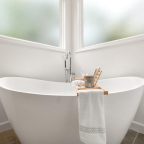
The Growing Popularity of Composite Decking in the UK and Ireland
Outdoor living spaces have become an essential feature of modern homes across the UK and Ireland. Whether it’s a cosy patio in a suburban garden or a stylish rooftop terrace in the city, decking plays a vital role in extending usable living space outdoors. In recent years, composite decking has emerged as a leading choice among homeowners, landscapers, and builders alike. Offering a perfect blend of aesthetic appeal, durability, and eco-friendliness, composite decking is transforming gardens and outdoor areas across the British Isles.
What Is Composite Decking?
Composite decking is a man-made building product made from a mixture of wood fibres, plastics, and bonding agents. These components are combined and processed to create boards that mimic the appearance of natural timber but come with several performance advantages.
There are two primary types of composite decking: capped and uncapped. Capped decking features a protective polymer shell for enhanced resistance against staining, moisture, and fading. Uncapped varieties are still highly durable but may require a little more care over time.
Why Homeowners Are Choosing Composite Decking
1. Low Maintenance Requirements
One of the key attractions of composite decking is its minimal maintenance needs. Traditional timber decks require regular sealing, sanding, and staining to prevent warping, rotting, or pest damage. In contrast, composite decking is engineered to withstand the elements with little more than an occasional clean using soap and water. This makes it especially appealing to busy homeowners or those who prefer to spend their time enjoying their garden rather than maintaining it.
2. Durability and Longevity
Thanks to its blend of plastic and wood fibres, composite decking offers excellent resistance to moisture, mould, and insects. It doesn’t splinter or crack like wood, and it can withstand the wet, temperate climate typical of the UK and Ireland. Most composite decking brands offer warranties of 20 to 30 years or more, ensuring a long-lasting investment.
3. Environmentally Friendly Option
Sustainability is a growing priority for consumers, and composite decking appeals to eco-conscious homeowners. Many manufacturers use recycled plastics and reclaimed wood fibres in the production process, diverting waste from landfills. Furthermore, because composite decking doesn’t require harmful chemicals for treatment or maintenance, it has a smaller environmental footprint over its lifecycle compared to treated timber.
4. Aesthetic Versatility
Composite decking is available in a wide range of colours, finishes, and grain patterns. Whether you prefer the rustic look of weathered timber or a sleek, modern aesthetic, there's likely a composite option that fits your vision. Some boards are even reversible, offering two different finishes in one product.
5. Slip Resistance
Safety is a major concern when it comes to outdoor flooring—especially in areas that see a lot of rain. Composite decking typically has a textured surface that offers better slip resistance than traditional timber, making it a safer option for families with children or older adults.
Market Growth and Industry Trends
The composite decking market in the UK and Ireland has grown rapidly over the last decade. What was once considered a niche or premium product has now become mainstream, with both DIY enthusiasts and professional landscapers embracing its benefits.
Expansion of Product Lines
Leading manufacturers such as Trex, Millboard, and EnviroBuild have significantly expanded their product lines to cater to different budgets and design preferences. Entry-level ranges provide homeowners with affordable yet reliable decking options, while high-end ranges offer enhanced durability, fade resistance, and luxury finishes.
Increased Availability in Retail Stores
Composite decking is now widely available through major home improvement chains such as B&Q, Wickes, and Woodie's, as well as through online retailers and specialist suppliers. This accessibility has made it easier for homeowners to compare products and prices, further driving demand.
Growth in Landscaping and Outdoor Living Markets
The surge in demand for outdoor living spaces, spurred in part by lifestyle changes during and after the COVID-19 pandemic, has also played a key role in composite decking's popularity. Homeowners increasingly view their gardens as extensions of their homes—places to relax, entertain, and spend quality time with family. Composite decking provides a practical and attractive solution for creating functional outdoor zones.
Regional Preferences and Climate Considerations
The climate in the UK and Ireland can be unpredictable, with frequent rain and fluctuating temperatures. These conditions can quickly degrade traditional wooden decking if not properly maintained. Composite decking’s weather resistance makes it an ideal solution for these regions.
In coastal areas of Ireland or seaside towns in the UK, salt-laden air can accelerate the deterioration of wood. Composite materials, especially capped varieties, are far more resilient in such environments, which has helped boost their adoption in these regions.
Potential Drawbacks to Consider
While composite decking offers many advantages, it’s important to acknowledge some of the potential downsides:
Higher Initial Cost: Composite decking tends to be more expensive upfront than pressure-treated wood. However, the lower maintenance and longer lifespan often justify the initial investment.
Heat Retention: Some composite boards can become hot under direct sunlight, although newer products are designed to minimise this.
Appearance Over Time: While high-quality composites resist fading, lower-end products may show wear or discolouration over time if not properly cared for.
Installation Considerations
Composite decking is generally easy to install using standard tools from a hardware shop, and many products come with hidden fastener systems for a clean, screw-free look. However, proper installation is crucial to ensure long-term performance. Following the manufacturer's guidelines—including spacing requirements and ventilation—helps prevent issues such as warping or moisture retention beneath the boards.
For those less confident with DIY, hiring a professional installer is often recommended. Many landscaping firms across the UK and Ireland now specialise in composite decking projects, offering custom designs, step construction, built-in seating, and more.
The Future of Composite Decking in the UK and Ireland
As environmental awareness grows and outdoor living continues to trend upward, composite decking is expected to become even more prominent. Advances in technology and design are continually improving the realism, durability, and sustainability of composite boards.
Furthermore, regulatory efforts to promote sustainable construction and reduce carbon emissions may further encourage the use of recycled and long-lasting building materials, reinforcing the case for composite decking.
Final Thoughts
Composite decking has firmly established itself as a popular, practical, and stylish alternative to traditional timber across the UK and Ireland. Its combination of low maintenance, durability, eco-friendliness, and design versatility makes it ideal for homeowners looking to enhance their outdoor spaces without the hassle of regular upkeep.
Whether you're creating a garden retreat in Dublin or a rooftop deck in Manchester, composite decking offers a modern solution for long-lasting beauty and performance. As demand continues to rise, the variety of options will only expand, making it easier than ever to find the perfect match for any home or lifestyle.

















